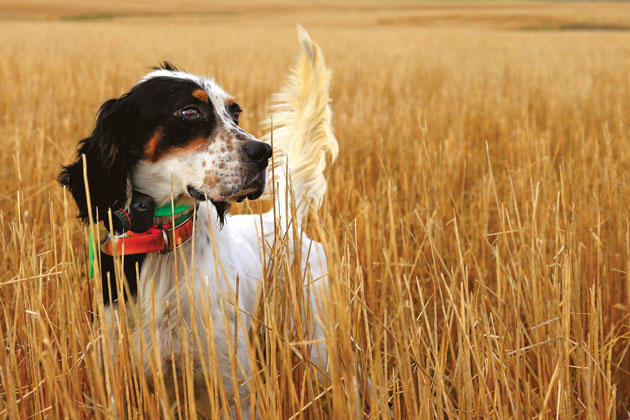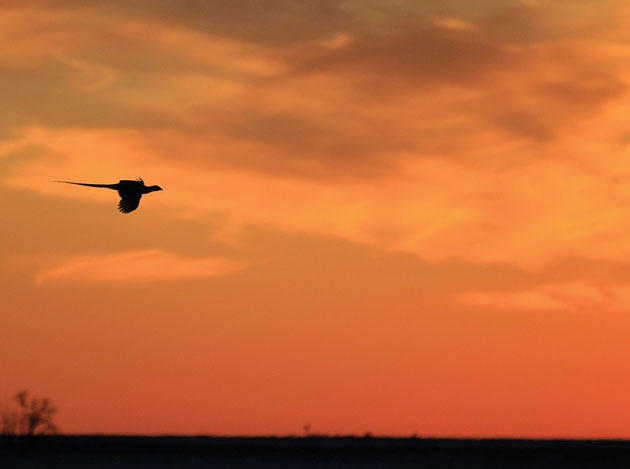An excerpt from Sporting Classics’ March/April 2015 issue, on newsstands March 4.
Football Coach Lou Holtz famously said, and he meant this not just about football but about life in general: “You’re either growing or you’re dying.” True enough, but when it comes to hunting, sometimes you’re just taking it easy.
I remember a morning on the Eastern Shore of Maryland back in the heyday when more than a million Canada geese were wintering on the Delmarva Peninsula. We hunted early in the season and a warm front had moved in with an expected high in the mid-50s. By dawn, a thick fog still hung on the ground, shrouding the rows of cornstalks and reducing visibility to less than 100 yards. We had just finished setting out some eight dozen silhouette decoys and were in the pit loading up when the action started. No calling, no black-flag waving, no nothing.
The tougher the hunt, the greater the reward, whether in this world or the next.
The birds just began to pile in, wings cupped and floating through the mist right down to us, totally unaware that we lay in wait below. Each of us had our limit in a few minutes. Back at camp we took a nice mid-morning nap and then shucked a few dozen oysters that afternoon. Not having to go back out and with the oysters on ice, we decided early cocktails were in order. It was even warm enough to relax out on the back porch.
Cakewalk hunts like that leave you with a tinge of guilt. It’s not that you cheated, but you know you didn’t break a sweat either. The Hunting Gods, of course, keep a record of such excursions and plan their revenge accordingly. It’s their way of reminding us that the tougher the hunt, the greater the reward, whether in this world or the next.

Most every veteran bird-hunter would agree that pheasant hunting ranks right up in the top tier of wingshooting challenges. Native birds have sharp eyesight and keen hearing and, like a great scrambling quarterback, can gain yardage on you both in the air and on the ground. Wily and wary to begin with, roosters truly wise up when the hunting pressure is on and are well on their way to earning graduate degrees in survival by the time the season is a few weeks old.
No other state is more famous for pheasant hunting than South Dakota, but gunning truly wild pheasants is an increasingly rare treat for non-residents looking to hunt from one of the state’s many top-notch lodges. Most lodges simply do not have the acreage to sustain all-wild hunting throughout the season. Not so at Brown’s Hunting Ranch in Gettysburg, located about 60 miles north of Pierre, the state’s capital.
Part of a family-farm operation, Brown’s holdings include 100,000 acres, mostly in sunflowers, around the lodge and another 50,000 along the Bighorn River and mountains in Montana. If you have an East Coast perspective, those acres translate into close to 20 percent of the size of Rhode Island. I was not surprised to learn that the Brown farm is, in fact, the largest producer of sunflower seeds in America.
This past November I had the opportunity to hunt at Brown’s courtesy of the good folks at Benelli who had chosen this challenging venue to introduce a group of outdoor writers to the company’s first over-and-under shotgun, designated the Model 828U. Our four days of hunting provided an unusually rigorous test of guns and gear as well as those of us who ventured afield.
Folks in the Dakotas like to say the tallest thing between them and a mass of arctic air is a four-strand barbed-wire fence. I’ll agree to that. During our stay, a Polar Vortex descended over the high plains, bringing snow and plunging temperatures into the single digits, with highs just barely sneaking into the teens. Icy winds that gusted to 30 miles-per-hour dropped the wind-chill factor to well below zero. A day of duck hunting, a nice addition that Brown’s offers during waterfowl season, had been on the original menu, but had to be cancelled since every pond in the area had frozen solid.
It was both a magnificent as well as discouraging sight.
Irish Setter had sent each of us a pair of their classic upland boot, the 984, a few weeks before the hunt. When we arrived at the lodge, however, we were happy to find that they had also brought a good supply of their Deer Stalker model, which features 800 grams of Thinsulate!
After an introduction to the new Benelli 828U on our first morning and, fortified with some of the tastiest homemade vegetable soup I can remember, we headed out for our first afternoon hunt. I was paired with Phil Bourjaily, shotgun editor of Field & Stream, and Frank Singleton whose outfit does PR work for Benelli.
Brown’s does not plant separate food plots for pheasants. With acres of sunflowers that stretch to the horizon pockmarked by huge cattail sloughs, there’s no need for additional food or cover. Late in the season, and especially when it’s bitterly cold and windy, the cattails offer the perfect haven for the birds and, not surprisingly, that’s where our cold but resolute band of hunters and guides headed.

There are two things about punching through chest-high cattails. First, it’s tough going and second, there’s no quiet way to do it. Each step results in a loud crunching sound of dry reeds snapping underfoot. For the birds, it’s like a high-decibel warning alarm going off and, sure enough, we had taken only a few steps into the thick cover when dozens of roosters and hens started to flush out of the cattails a hundred yards ahead of us. It was both a magnificent as well as discouraging sight. It seemed our hunt was over before it hardly began.
My years of pheasant hunting, however, told me otherwise. It may seem that every pheasant in the area has flown the coop after that first big flush, but there are always a few birds that stay hunkered down. Steamrolling through the countryside like Sherman’s army on its “March to the Sea” is not, however, a winning strategy with tight-holding pheasants. The key to getting in range is to slow your pace; indeed, to pause for a few seconds after each few steps. A cautious and meandering approach tends to confuse the birds and keeps them from sprinting away.
Our stealthy approach soon paid dividends, and after a couple of hours we had shot some beautiful roosters and watched our two Labs make some great retrieves. As the sun began to drop and our fingers began to numb, we headed back to the lodge. It had been a bracing afternoon, but just a taste of what was to come. . . .
To finish the story, be sure to subscribe or pick up the new issue of Sporting Classics when it hits newsstands March 4.
Cover image: Dean Pearson

